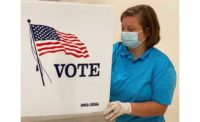The following was told to ACHR News business management editor Ted Craig. It has been edited for style.
It all started after the Civil War. Lewis Leeds, who ran hospitals for the Army and then was part of the Franklin Institute after the war, was like the Dr. Fauci of his time. He and Harriet Beecher Stowe, of “Uncle Tom’s Cabin” fame, were convinced that Americans were dying from what they called “vitiated air.” They labeled it the national poison.
It was also a time when America had a lot of immigration. You had a lot of people coming in and living in tenements. There was a tremendous amount of sickness — cholera and diphtheria and tuberculosis. This is before Pasteur — before germ theory. Nobody understood what caused diseases. They thought it came from being in an enclosed space and breathing out toxic vapors.
Leeds wrote a book about “vitilated air,” and he and Stowe went on the road with a lantern light show. In the show, you had a father and a mother sitting in a room, and you could see vapors coming off their bodies. In crawls a toddler in a bonnet with a long gown. She crawls into the vapor and then topples over in the next slide. They scared the crap out of people! At this point, there was no central heating; people were using stoves and fireplaces, and the message was that this is what will happen to your family if you don’t open the window. Lewis and Stowe’s work started what was called “the fresh air movement.”
At the turn of the century, heating became safer. Up until this point, steam boilers in people’s buildings were running at 60 psi, which is crazy. There were no relief valves, and there was no testing. There was no ASHRAE. There was no one inspecting the boilers to say whether they were safe. As a result, there was a boiler exploding every day and a half. They were blowing up hotels and apartment buildings and big mansions. A group got together that would eventually become the Hydronics Institute. They set the price for boilers, and they also mandated that every boiler should run at 180 degrees and every steam boiler should run at no more than two pounds of pressure. That made it safe.
Then came World War I, and the Spanish Influenza of 1918, which killed 50 million people worldwide. Boards of health across the country started to tell people to leave their windows open to let in fresh air. After the stock market crashed, people started pushing back: “Coal is expensive — why do we have the windows open?”
So during the Depression, and when it was determined that the Spanish influenza wasn’t coming back, they closed the windows. But now you have these radiators sized to heat an apartment with the windows cracked, even in winter. With the windows closed, the oversized radiators were overheating the rooms. So people started putting covers over the radiators to cut down on how much heat was emitted, and that helped a bit. Then the government got involved, and scientists at the National Board of Standards found that paint with metal particles would cut the radiator’s ability to radiate by 20 percent. It’s called bronzing, and the paint has either gold or aluminum particles. That’s why radiators are colored silver or bronze.
Today, we’re going through the exact same thing. We’re talking about new passive houses that are so tight you have to build in all kinds of air exchanges. Then you have the buildings built after World War II, where the windows don’t open. After the ‘70s, they definitely don’t open because we were trying to save fuel. In fact, there was a big movement to replace the windows in old buildings. Then people found out that when they replaced the drafty old windows, mold would start to grow because the new sealed-off windows had no air exchange. They wound up drilling holes in the metal parts of the replacement window to make them work like the old windows.
That’s why we don’t have the best balanced systems in the world. That’s why in a lot of offices, you’ll find heaters under desks. Now people are saying they can’t go back to work unless they have these super-high-efficiency filters to provide clean air.
Now look at the old steam-heated buildings in New York. All they have to do is open a window.






